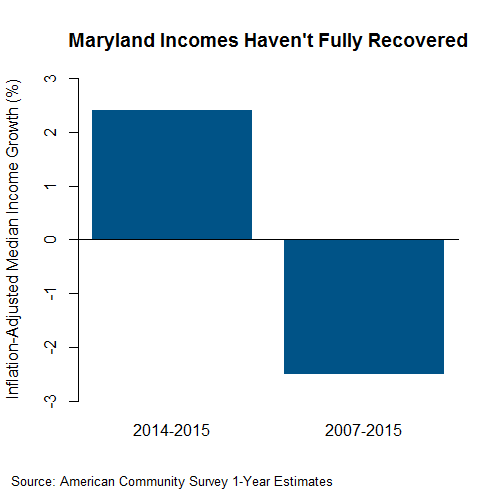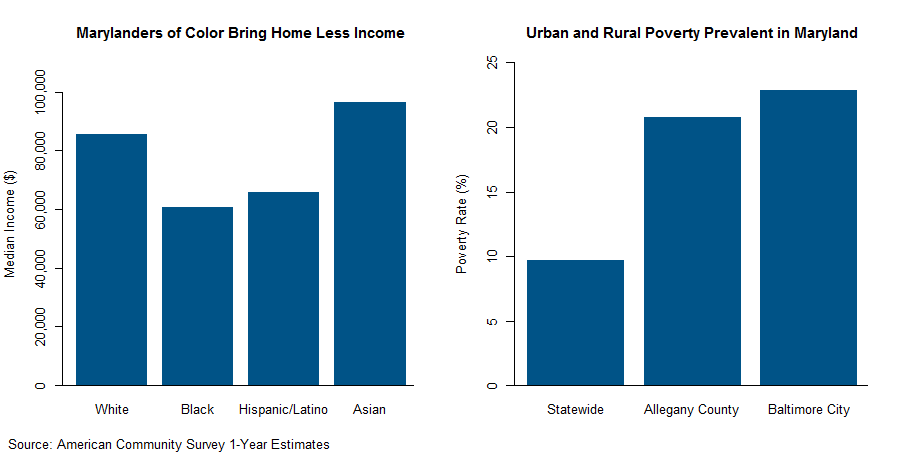Rising Incomes in the State Still Leave Too Many Marylanders Behind
Last year, typical Maryland families saw their largest income gains since the Great Recession. At the same time, about one in 10 state residents still struggle to afford basic necessities such as food and housing. While last year’s progress is welcome, the state needs policies that support workers and make sure everyone can experience the benefits of a growing economy.
Income for a typical Maryland household grew by 2.4 percent in 2015 after adjusting for inflation, according to data released last week by the Census Bureau. This is the third consecutive year of income growth for middle-class families in the state and the largest single-year gain Although Maryland remains the wealthiest state in the nation, income did not grow as quickly in Maryland as in the rest of the country, and last year’s growth was not enough to make up the losses from the downturn. A typical Maryland household still takes home about $2,000 less in inflation-adjusted terms than in 2007.
Even as median income grows, too many state residents have been left behind. Last year, one in every ten Marylanders were struggling to make ends meet with incomes below the federal poverty line, about $24,000 per year for a family of four. About 275,000 people lived on less than half that amount –that means just $12,000 for a family of four to cover all basic necessities for a year. Maryland children have it the hardest, with one in eight living in a family that struggles to make ends meet. Children who grow up in poverty have a harder time succeeding in school and finding a good job later in life due to the stress associated with their family’s financial constraints.
As with income, Maryland’s poverty rate is still higher than it was before the recession. While poverty decreased in 2015, it was not a significant decline. If we got the state back to where it was in 2008, it would mean 100,000 more Marylanders with enough money to meet their basic needs.
What’s more, the benefits of the state’s improving economy are not evenly distributed. People who live in the most rural or urban parts of the state face a greater risk of economic hardship, as do black and Hispanic Marylanders. This is a concern because our success as a state depends on opportunity for everyone.
- One in every five residents of Baltimore City and Allegany County lives below the poverty line, including more than a third of children living in Baltimore.
- A typical black family in Maryland took home only $61,000 last year, compared to $66,000 for a Hispanic family and more than $85,000 for a non-Hispanic white family.
- Black and Hispanic Marylanders were more than twice as likely as whites to lack the resources to afford basic necessities.
Income gains like those Maryland and the rest of the country have seen in the past year are a cause for celebration, but more needs to be done to make sure that everyone benefits. We can take three steps to improve the economy so that next year’s news is even better:
- Make sure all workers can earn a living wage. By fixing holes in the current minimum wage law, we can ensure that tipped workers get fair pay for their work. Local minimum wages are also needed where the cost of living is highest. Research shows that raising the minimum wage does not cost jobs, and more purchasing power for workers means more income for everyone.
- Expand access to the Earned Income Tax Credit. The EITC is a common-sense tax break with bipartisan support that helps those who work but struggle to get by on low wages. However, it currently bypasses too many people. Expanding this tax credit to young workers and workers not raising children in their homes would yield gains for our economy.
- Guarantee paid sick days. About 700,000 Maryland workers currently have to choose between working through an illness and losing pay—or even risking their jobs. Part-time and low-wage workers are the least likely to have access to paid sick leave. Guaranteeing all workers time off when they are sick would create greater financial security for hundreds of thousands of Marylanders, as well as a healthier and more productive workplace for everyone.


